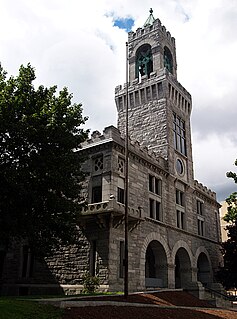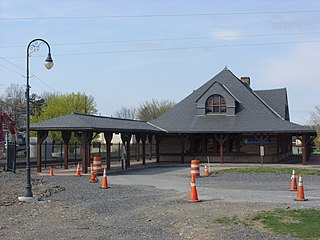
Richardsonian Romanesque is a style of Romanesque Revival architecture named after architect Henry Hobson Richardson (1838–1886). The revival style incorporates 11th and 12th century southern French, Spanish and Italian Romanesque characteristics. Richardson first used elements of the style in his Richardson Olmsted Complex in Buffalo, New York, designed in 1870. Multiple architects followed in this style in the late 1800s; Richardsonian Romanesque later influenced modern styles of architecture as well.

Henry Hobson Richardson was a prominent American architect, best known for his work in a style that became known as Richardsonian Romanesque. Along with Louis Sullivan and Frank Lloyd Wright, Richardson is one of "the recognized trinity of American architecture".

John Galen Howard was an American architect who began his career in New York before moving to San Francisco, California. He was the principal architect at Howard, Cauldwell & Morgan and employed Julia Morgan early in her architectural career.
Norcross Brothers Contractors and Builders was a prominent nineteenth-century American construction company, especially noted for their work, mostly in stone, for the architectural firms of H.H. Richardson and McKim, Mead & White. The company was founded by James Atkinson and Orlando Whitney, who were contracted for their first project in 1869. In all, the company is credited with completing over 650 building projects.

The Ames Building is a hotel and skyscraper located in Boston, Massachusetts. It stood as the tallest building in Boston from its completion in 1893 until 1915, when the Custom House Tower was built; however, it was not the tallest overall structure in Boston, as the steeple of the 1867 Church of the Covenant was much taller than the Ames Building. Nevertheless, it is considered to be Boston's first skyscraper. In 2007, the building was converted from office space to a luxury hotel.

Shepley, Rutan and Coolidge was a successful architecture firm based in Boston, Massachusetts, operating between 1886 and 1915, with extensive commissions in monumental civic, religious, and collegiate architecture in the spirit and style of Henry Hobson Richardson.

Hartford Union Station is a railroad station in Hartford, Connecticut, United States on the New Haven–Springfield Line. It is served by Amtrak Hartford Line, Northeast Regional, Valley Flyer, and Vermonter intercity rail service, plus Hartford Line commuter rail service.

New London Union Station is a historic regional rail station located in New London, Connecticut, United States. Located on the Northeast Corridor, the busiest railway in the United States, it is the primary railroad station in southeastern Connecticut. Union Station is a station stop for most of Amtrak's Northeast Regional trains and a small number of high-speed Acela Express trains. Certain ConnDOT Shore Line East commuter rail trains also stop at New London, making it the eastern terminus of commuter rail in Connecticut.

The Converse Memorial Library – also known as Converse Memorial Building – is a historically significant building designed by noted American architect H. H. Richardson. From 1885 to 1996, it housed the Malden Public Library, which now occupies a modern building adjacent to it. The former library is located at 36 Salem Street, Malden, Massachusetts.
Shepley Bulfinch is an international architecture, planning, and interior design firm with offices in Boston, Hartford, Houston, and Phoenix. It is one of the oldest architecture firms in continuous practice in the United States, and was recognized by the American Institute of Architects with its highest honor, the AIA Architecture Firm Award, in 1973.

The Downtown New London Historic District, also known as the Waterfront Historic District, refers to 78 acres (32 ha) with 223 contributing buildings along the waterfront of New London, Connecticut. It was added to the National Register of Historic Places (NRHP) in 1979, with 190 buildings and 60 acres (24 ha). The district was expanded in 1988, adding 18 acres (7.3 ha) and 33 buildings.

Shadyside Presbyterian Church is a large congregation of the Presbyterian Church (U.S.A.) in an historic part of Pittsburgh, Pennsylvania, United States. Located at the corner of Amberson Avenue and Westminster Place in the Shadyside neighborhood, Shadyside Presbyterian Church was founded in 1866 as a congregation in the Presbyterian Church in the U.S.A. and has enjoyed a long history of local, national, and global recognition for its outreach and service.

The Newton Railroad Stations Historic District in Newton, Massachusetts is composed of three geographically separate historic railroad stations and one baggage/express building on the former Boston and Albany Railroad Highland Branch, which was converted to MBTA Green Line D branch in 1959.

Hampden County Courthouse is a historic courthouse on Elm Street in Springfield, Massachusetts designed by Henry Hobson Richardson. This was the county's second courthouse. The first courthouse was a small meetinghouse structure built in 1740, and the second and was constructed in 1822, but by the 1860s, popular pressure was developing for a new proper courthouse. A grand jury indicted the county commissioners in 1869 for official misconduct since the courthouse did not have fireproof storage for the registry of deeds and the safekeeping of public records. This forced the county to build a new courthouse.

Union Station served the residents of Chatham, New York, from 1887 to 1972 as a passenger station and until 1976 as a freight station. It was the final stop for Harlem Line trains. It had originally served trains of the Boston and Albany Railroad, then the New York Central Railroad and the Rutland Railway. It served as a junction for service that radiated to Rensselaer, New York, on the northwest, Hudson, New York, to the southwest, northeast in southwestern Vermont and Pittsfield, Massachusetts and New York City to the south.

The John N. Bagley House is a private residence located at 2921 East Jefferson Avenue in Detroit, Michigan. It was listed on the National Register of Historic Places in 1985.

The Union Street Historic District is a historic district on Union Street between Langley Road and Herrick Road, and at 17–31 Herrick Road in Newton, Massachusetts. It encompasses the city's only significant cluster of 19th century commercial buildings. It was added to the National Register of Historic Places in 1986.

Coraopolis station is a disused train station in Coraopolis, Pennsylvania. The train station was built in 1896 by the Pittsburgh and Lake Erie Railroad, and designed by architects Shepley, Rutan and Coolidge in Richardsonian Romanesque style.

Warder Public Library is a historically significant building in Springfield, Ohio, United States. A robust example of Richardsonian Romanesque architecture, it was a gift to the city from industrialist Benjamin H. Warder, and served as the main branch of the Clark County Public Library from 1890 to 1989. It now houses the Clark County (Warder) Literacy Center.

Benjamin Head Warder was an American manufacturer of agricultural machinery, based in Springfield, Ohio, for much of his career. After he had retired, in 1902 the company he co-founded merged with four others to form International Harvester. Warder commissioned and donated a new library for Springfield in 1890, as a memorial to his parents.




















